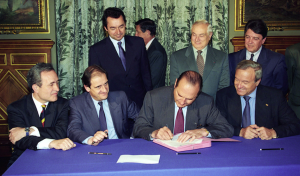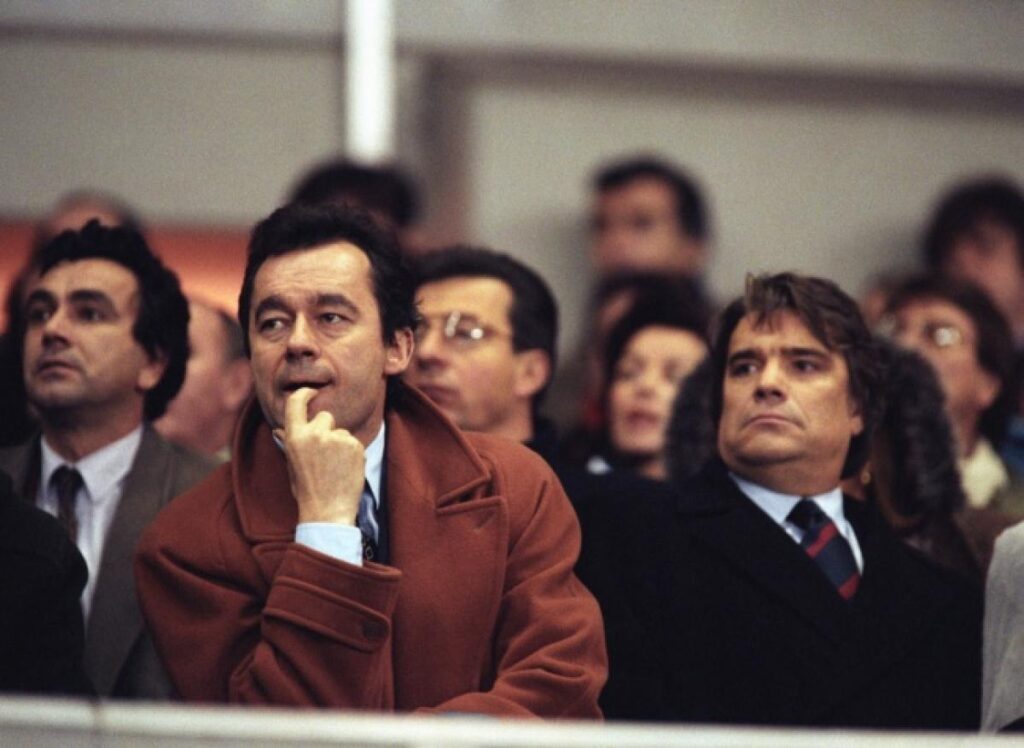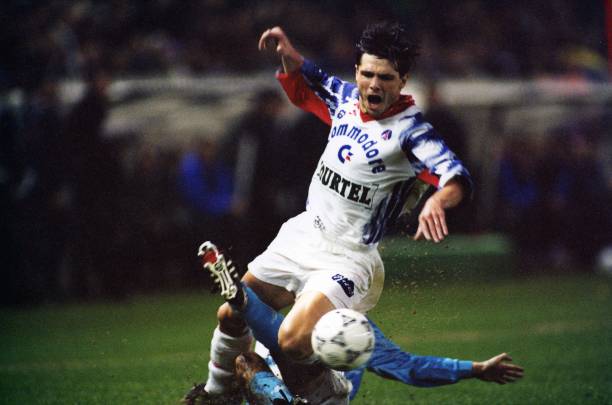Marseille and Paris. Two cities that seem to stand in total opposition. On one side, Paris, the elitist capital, a symbol of wealth and French elegance. On the other, Marseille, the quintessential working-class city rowdy, unruly, and dangerous. All the ingredients are there for their football clubs, Olympique de Marseille and Paris Saint-Germain, to develop a rivalry that has now become one of the most deeply rooted in French football.
But the true origins of this rivalry are far from the simplistic narrative of two cities at odds. In reality, they can be traced back to rational, calculated developments. From Bernard Tapie to Canal+, let’s dive into the beginnings of Le Classique, the biggest match in French football.
- OM like Marseille : constant need for opposition
September 12, 1971. Just one year after its founding, Paris Saint-Germain faced Olympique de Marseille for the first time in its history. PSG was still a very young club, a newcomer compared to Marseille’s long tradition. Founded in 1901, OM already generated a passion that the young PSG could not yet hope to rival.
To understand how the rivalry was born, one must first understand Marseille’s identity. That identity explains the club’s constant need for rivalry. Marseille has long stood as the last great popular city, with its suburbs integrated into the heart of the urban fabric. Given the city’s structure, football concerns everyone. OM is not just the representative of the working classes, nor only of Marseille natives. Instead, the diverse diasporas within the city made cosmopolitanism one of the key reasons for OM’s success. As sociologist Christian Bromberger once said in Football, la bagatelle la plus sérieuse du monde: “It is a common trait for newcomers to hyper-identify with their adopted city, as if paying a symbolic price for their integration.”
In this way, OM became the connector of all the city’s differences. Furthermore, Marseille’s bad reputation shaped by history and stereotypes only reinforced identification with a club that never claimed ownership of a specific social class or political stance. OM belonged to all Marseillais. Its constant search for symbols and meaning was first channeled into a rivalry with Bordeaux.
Bordeaux, a prosperous, wealthy, and elitist city, soon became Marseille’s first rival. Bordeaux was not only a sporting competitor but also a city trying to claim the title of best club in southern France.
Then came 1986. Bernard Tapie bought OM. Before becoming the well-known politician, Tapie was a businessman with a sharp instinct for opportunities. His rivalry with Bordeaux’s president, Claude Bez, helped him make a name for himself in French football. But what truly established him as a central figure was an OM–PSG match during the 1987–1988 season. PSG won 2–1, but Tapie stormed onto the pitch to berate the referee, as if to demonstrate that in Marseille, he was the one who made the rules.
By the late 1980s, OM was one of France’s leading clubs, with Tapie aiming to make it a legitimate contender for the European Cup. PSG, meanwhile, was also gaining momentum. Having won the French championship in 1986, just sixteen years after its founding, PSG regularly challenged at the top of the table. With Bordeaux relegated to Ligue 2 following financial troubles, OM–PSG clashes became the new fixtures at the summit of French football.
- CANAL + and the shaping of a rivalry
Y’a plus important qu’un OM – PSG actuellement pic.twitter.com/NkOza9FhlY
— 𝐊𝐈𝐋𝐎 🇫🇷 (@Tsailemec_) September 21, 2025
Enter Canal+, the exclusive broadcaster of French football at the time. Driven by Paris mayor Jacques Chirac, his advisor Bernard Brochand sought out strong and ambitious investors for PSG, as the city government was tired of footing the club’s financial struggles.

On May 31, 1991, Canal+ officially took over PSG. The club would now be governed by two entities: 51% held by the club under Bernard Brochand, and Canal+ represented by Pierre Lescure, with Michel Denisot appointed as president delegate and de facto leader of the team. The city of Paris absorbed the club’s 50 million franc deficit, guaranteed an annual subsidy of 30 million, and became a privileged partner. Former president Francis Borelli was named “honorary president for life.” A new era had begun for PSG.
Canal+ wanted to create a club capable of competing with OM in order to secure the long-term future of the French championship. For the television network, PSG was also a way to gain more influence over Ligue 1 broadcasting rights. With Canal+ money, PSG now had the means to become competitive for the long run.

From the very first season under Canal+, Tapie capitalized on the strong sociological contrasts between Paris and Marseille. As journalist Jean-François Pires explained in his book PSG-OM / OM-PSG: The History of a Rivalry: “Historically, Marseille has always had complicated relations with Paris, always felt mistreated even during the monarchy. It’s the only city where royal fortifications were built not to protect the city, but to protect from the city, with cannons pointed inward. Football executives used the sport to ignite something that had always been simmering. Everything was in place for this to become ‘France’s derby.’”
Canal+ leaned into these dynamics, amplifying the rivalry through media coverage, strong symbolism, and regular presidential interventions. OM was then at its peak just before winning the Champions League and knew that having PSG as a challenger only raised the league’s competitiveness.
- The rivalry peaks in the early 1990s
The rivalry reached a turning point during the 1992–1993 season. OM and PSG were far ahead of the competition, and their December 18 clash was already seen as decisive. The build-up was marked by fiery declarations David Ginola promised “war,” and PSG coach Arthur Jorge claimed his team would “walk over OM.” The match lived up to the hype: 55 fouls, brutal tackles, and a level of physical aggression that today would have produced a flood of red cards. “Engaged and passionate,” is how PSG’s Laurent Fournier later described it. The return match, just five days after OM’s Champions League triumph, was marred by crowd trouble, showing how much these games stirred emotions on and off the pitch. Yet, behind the passion lay a striking contrast: the cordial, even friendly relationship between the two presidents, Tapie and Denisot. As Christophe Bouchet, OM’s president from 2002 to 2005, later observed: “Cynicism is fighting battles but keeping your distance from them.”

OM wins it in 1992
In the end, the idea that Le Classique was purely invented by Canal+ and Bernard Tapie oversimplifies reality. The rivalry also draws from deep-rooted sociological tensions between the capital and the provinces, a recurring theme across French football rivalries. Tapie and Canal+ had the merit of exploiting these dynamics, turning them into an antagonism that became deeply embedded in French culture. Even though PSG’s Qatari-backed dominance since 2011 has tilted the balance massively at the national level, the OM–PSG rivalry remains a defining feature of French football.